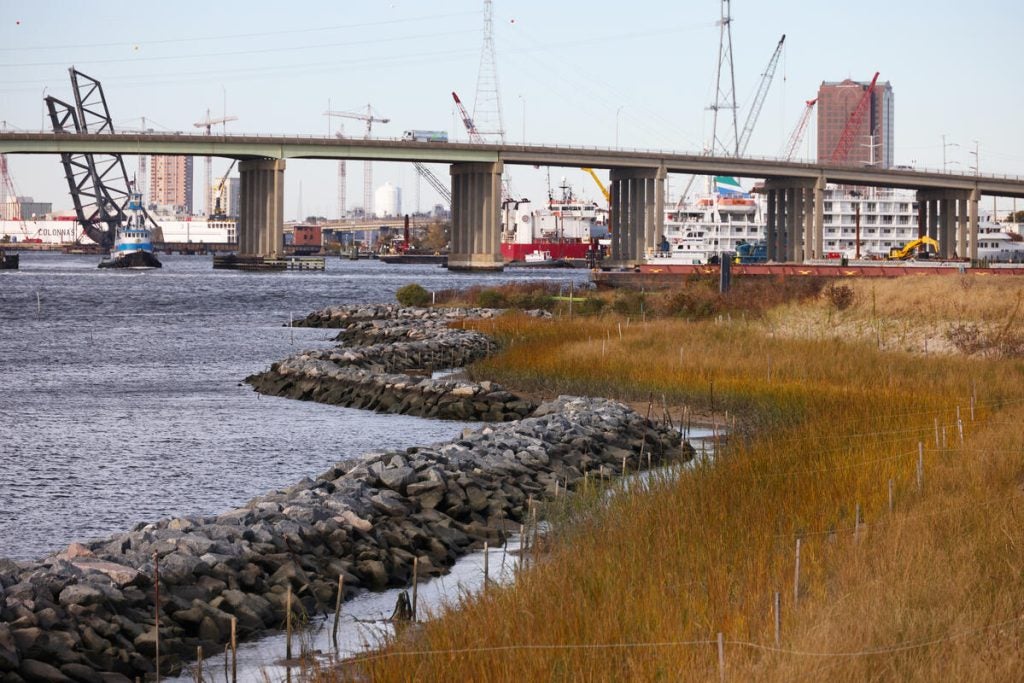In early December 2022, the Biden-Harris administration announced the release of a Roadmap to Accelerate Nature-Based Solutions to address climate change, inequity, and nature loss. This roadmap outlines five strategic recommendations for federal agencies designed to put the U.S. on a path to maximizing the use of nature-based solutions.

Chesterfield Heights – Historic neighborhood with living shoreline construction project comprised of a raised berm (a mound of ground), grass plantings, wetland restoration, oyster reefs, and storm drains.
Nature-based solutions are essential to ensuring people and nature thrive
Building on the momentum from President Biden’s Executive Order 14072, which acknowledged nature-based solutions as key to tackling the climate crisis, the roadmap marks the first instance of a U.S. strategy aimed at scaling up these solutions. This strategy highlights the effectiveness of natural infrastructure and emphasizes the multiple benefits created by the improvement of human, economic and ecosystem health.
Other interagency commitments aligned with the roadmap were also announced, including agency actions to ensure over $25 billion in infrastructure and climate funding to support nature-based solutions, a new guide for utilizing nature-based solutions to ensure resilience of military bases and a new technical working group to better account for nature-based options in benefit-cost analyses that inform federal decisions. A companion resource guide was also released, with examples of nature-based solutions and over 150 resources to spur action.
Five strategic recommendations for maximizing these solutions
However, many agencies, tribal nations, and stakeholders have identified significant challenges to putting these solutions into action. A lack of awareness, hurdles in current policies and regulations, insufficient or over-complicated funding, and the shortage of a workforce that can engineer these solutions often hinder stakeholders from scaling up natural infrastructure practices. However, the Roadmap is an all-of-government approach, aiming to tackle these challenges by providing federal agencies with five synergistic recommendations:
- Update federal policies and guidance, making it easier to consider and adopt nature-based solutions. The roadmap encourages agencies to update federal policies and offers guidance to make it easier for nature-based solutions to be considered. The major areas for advancement include policies and guidance for federal planning, permitting, cost-sharing, risk management and benefit-cost analysis.
- Unlock funding for domestic and international projects and encourage federal agencies to prioritize nature-based solutions in funding decisions. Integrating nature-based solutions into financial assistance and incentive programs, as well as increasing the amount of funds available, can help to scale-up the use of nature-based solutions. There are key funds from the Bipartisan Infrastructure Law (BIL) and the Inflation Reduction Act (IRA) for resilient infrastructure, and simplifying access, increasing coordination, and streamlining application processes can ensure this funding will serve its intended purpose.
- Lead with federal facilities and assets that provide direct climate and conservation benefits and send a strong signal to others. The roadmap recommends that federal agencies continue efforts to improve resilience in their facilities, operations, and programs by requiring the use of nature-based solutions (i.e., expanding green stormwater infrastructure, living shorelines, or green roofs), where applicable.
- Utilize agency programs to train a knowledgeable workforce. Agency programs can help train individuals to develop the skills needed to plan, design, build and maintain nature-based solutions. Developing a diverse, equitable workforce can fill the skill gaps in community planning, law, finance, ecology, engineering, and maintenance for these projects.
- Prioritize research, innovation, knowledge and adaptive learning. The roadmap recommends that agencies incentivize continual learning about how and where nature-based solutions work best. Agencies are encouraged to review existing research on nature-based solutions, develop interagency best practices for monitoring the benefits of nature-based solutions, and improve their adaptive management processes.
The roadmap will be a key resource in future resilience planning
The roadmap showcases a strong federal commitment towards a future where nature-based solutions are a first choice for combating climate change, addressing injustices, creating prosperous communities and building resilient infrastructure. Though new challenges will emerge, the roadmap provides a guide to using these solutions as powerful tools to increase resilience now and in the future.









